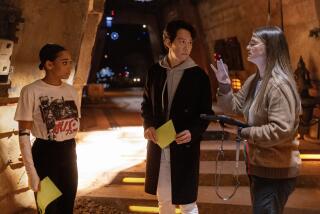‘Next Generation’ Didn’t Fly So Boldly
- Share via
Although “Star Trek: The Next Generation” has ended, the series has fallen far short of reaching the final frontier.
In his appreciation, “Trekking Off With Mission Accomplished” (Calendar, May 23), Times staff writer Daniel Cerone described the series as presenting an “idealized future.” The show has several excellent features but in no way should its vision of the future be lauded as ideal. Whereas the original “Star Trek” featured an interracial cast in key roles, the “Next Generation” has continually presented a traditional hierarchy. White males are in command, minorities are hidden or absent, and the females are care-givers.
After almost 30 years, the Enterprise still has not gone where no one has gone before. This traditional scenario speaks more to the present than any fictional utopia. Granted, the acting is superb and often the writing transcends the show’s conservative conceit. Yet the only serious flaws Cerone cites refer to costume and set design.
The original series was revolutionary in its use of female and minority characters. The producers have made some positive changes to the personnel in two decades; we no longer see nurses in mini-skirts aiding male doctors. On “Next Generation,” two female regulars were the chief medical officer and the ship’s counselor.
Yet why would a ship counselor be included among the senior officers, except as a token female? Her character belongs more to a talk-show panel than to the bridge of an exploring starship where her abilities have only marginal benefit. An enemy ship fires on the Enterprise and she reports from her easy chair, “The aliens are angry, Captain, and the crew is concerned.”
The original “Star Trek” boasted an interracial kiss between Lt. Uhura, a black woman, and Capt. Kirk. But African Americans have fared far worse in the intervening decades. In the “Next Generation,” the only regular black cast members are a Klingon, a blind engineer and a bartender--no commanders.
Asian Americans in the future are practically invisible. Apparently, Lt. Sulu was the last one. Any crew accurately representing a united Earth would undoubtedly contain a majority of Asians. Yet on the Enterprise they definitely remain in the minority.
Minorities and females have appeared as visiting guest stars but true innovation comes from permanent non-traditional casting. “I Spy” would not have been revolutionary if Bill Cosby had been only a recurring guest star. In “Next Generation,” alien races (with the exception of barbaric Klingons) are almost exclusively portrayed by white actors.
*
The most glaring example of the show’s Eurocentric mindset came in an otherwise excellent episode concerning the origin of human life in the universe. The writers sought to explain why so many humanoid races inhabited the galaxy. One scientist discovered DNA clues sprinkled over many planets. When assembled, these clues became a message from the original “mother race” of all the humanoids. The celestial “Mother-of-Us-All” was presented as a white female.
Back on Earth, most scientists agree that the first people to emerge from the plains of Western Africa were black people. Yet the “Next Generation” casting director would have us believe that a white woman sired the galaxy.
But the new show’s faults may not solely come from its creators, but rather from the times in which it premiered. Great science fiction seeks not to tell us about the future; it depicts the present but in fantastic settings and situations.
The original ‘60s “Star Trek,” with its “prime directive” emphasizing nonintervention, emerged directly from America’s ambivalence about Vietnam. The “Next Generation” appeared in the ‘80s when many Americans were quite content with conservative white males in charge.
If the “Next Generation” fails in its traditional casting, its spin-off, “Star Trek: Deep Space Nine,” certainly succeeds. An African American male plays the commander, females appear as the station’s executive officer and science officer.
Perhaps “Deep Space Nine” succeeds because the times in which it was created are more exciting. The collapse of the Soviet Union and apartheid can be seen in the show’s fictional universe. The tyrannical Kardassian empire retreats from an oppressed planet, leaving the people to experiment with democracy and new-found freedom. The violent rise of nationalism is illustrated by rebellious settlers fighting for recognition in the demilitarized zone.
If anything, “Star Trek” is a series about courage--demonstrated not only by characters faced with dangerous aliens, but shown by the series itself in the stories it tells. “Next Generation” did exhibit courage in many of its choices. It just did not boldly go far enough.
More to Read
The complete guide to home viewing
Get Screen Gab for everything about the TV shows and streaming movies everyone’s talking about.
You may occasionally receive promotional content from the Los Angeles Times.






